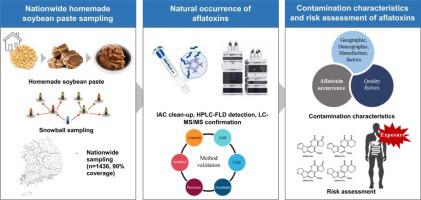Journal of Hazardous Materials ( IF 13.6 ) Pub Date : 2021-10-24 , DOI: 10.1016/j.jhazmat.2021.127576 Sang Yoo Lee 1 , So Young Woo 1 , Fei Tian 1 , A-Yeong Jeong 1 , Su Been Park 1 , Hyang Sook Chun 1

|
Soybean paste is manufactured through microbial fermentation and may become contaminated with aflatoxins. Herein, we conducted nationwide large-scale monitoring (n = 1436) over three years (2018–2020) to investigate aflatoxin levels according to geographic, demographic, manufacturing, quality factors, and risk characteristics of homemade soybean paste produced through fermentation. The mean level of total aflatoxins was 5.88 μg/kg (range, 0.01–281.92), with the most common contaminating type being the B type. Aflatoxin levels significantly differed according to the region, age of the manufacturer, type of starter used, and the amino-type nitrogen content and pH of the homemade soybean paste (p < 0.05). Aflatoxin levels was significantly higher when starters were manufactured using the traditional method (inoculation with a naturally occurring strain in the surrounding environment). The aflatoxin exposure level estimated through the average intake of homemade soybean paste in all age groups was 0.1012 ng/kg body weight/day. The risk assessment for the genotoxic and carcinogenic potential of aflatoxins using the margin of exposure approach revealed values of 3705–3954 for average intake of homemade soybean paste, indicating public health concern. These results suggest that follow-up studies and safety management strategies are needed to reduce aflatoxin levels in homemade soybean paste.
中文翻译:

韩国传统发酵豆制品自制豆酱中黄曲霉毒素的污染特征及风险评估
豆酱是通过微生物发酵制成的,可能会被黄曲霉毒素污染。在此,我们在三年(2018-2020)期间在全国范围内进行了大规模监测(n = 1436),根据地理、人口、制造、质量因素和通过发酵生产的自制豆酱的风险特征调查黄曲霉毒素水平。总黄曲霉毒素的平均水平为 5.88 μg/kg(范围 0.01-281.92),最常见的污染类型是 B 类。黄曲霉毒素水平因地区、制造商年龄、使用的发酵剂类型以及自制豆酱的氨基型氮含量和 pH 值而有显着差异(p < 0.05)。当使用传统方法(用周围环境中的天然菌株接种)制造发酵剂时,黄曲霉毒素水平显着升高。所有年龄组通过自制豆酱的平均摄入量估算出的黄曲霉毒素暴露水平为 0.1012 ng/kg 体重/天。使用接触边际法对黄曲霉毒素的遗传毒性和致癌潜力进行的风险评估显示,自制豆酱的平均摄入量值为 3705-3954,表明公众健康问题。这些结果表明,需要后续研究和安全管理策略来降低自制豆酱中的黄曲霉毒素水平。1012 ng/kg 体重/天。使用接触边际法对黄曲霉毒素的遗传毒性和致癌潜力进行的风险评估显示,自制豆酱的平均摄入量值为 3705-3954,表明公众健康问题。这些结果表明,需要后续研究和安全管理策略来降低自制豆酱中的黄曲霉毒素水平。1012 ng/kg 体重/天。使用接触边际法对黄曲霉毒素的遗传毒性和致癌潜力进行的风险评估显示,自制豆酱的平均摄入量值为 3705-3954,表明公众健康问题。这些结果表明,需要后续研究和安全管理策略来降低自制豆酱中的黄曲霉毒素水平。



























 京公网安备 11010802027423号
京公网安备 11010802027423号